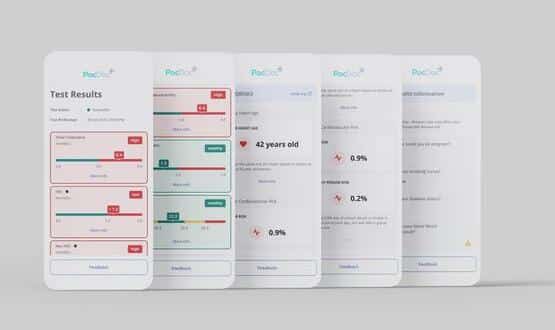Come hell or high water: North Cumbria opens IT-ready hospital
- 7 January 2016

Submerged cars, flooded homes and ruined shops have been the depressing staple of news footage of the devastating floods in Cumbria; both in the autumn and over Christmas.
Healthcare hasn’t escaped the impact of these biblical downpours: during the earlier deluge, several hospitals had to resort to generators to provide power; GP practices and pharmacies closed down due to water damage; and numerous appointments were cancelled.
One site that, luckily, wasn’t affected was the new West Cumberland Hospital, which only opened in October this year after three years of work and £90 million investment. Many local residents still struggle to believe the hospital even exists, however, as it is behind buildings put up in the 1960s.
Walk through the rather cramped, old reception room and carry on round a corridor and you finally feel like you’re stepping into the 21st Century when you come to a large, bright waiting area. This comes complete with self-check in kiosks and large screens with bus timetables, all around a garden courtyard.
Getting ready
The interior of the new site is certainly impressive and North Cumbria University Hospitals NHS Trust worked hard to make sure it had the IT infrastructure in place to match it.
Kevin Dickinson, who heads IT at both North Cumbria and the nearby Northumbria Healthcare NHS Foundation Trust, explains: “We were designing this five years ago. You have to think five years ahead to what people were going to be using.”
One of the major decisions the trust made was to put all the electrical services onto a single network running throughout the hospital. This was quite a departure from the disparate cabling that permeated the existing site and meant systems were using different fibres, speeds and connectors.
Stephen Harrison, assistant IT manager, says “There was a whole load of stuff that evolved over time. And we took this opportunity to try and converge that onto a single network that would be sustainable.”
Modernising the data centres at the hospital was another important task. There’s another huge contrast between the cramped, poorly ventilated, converted office spaces housing servers next to water pipes in the old site, and the well air-conditioned, purpose-built spaces in the new site.
More importantly, the infrastructure investment means myriad systems, including security cameras, doors, bedside observations and video conferencing in purpose built rooms function effectively. In a further commitment to getting basic things right, there is also a new, IP telephony system.
“Our concentration has been on the IT side, but actually the most important thing to a clinician is that they have a phone. So getting telephony right was key; but the telephone needed a network and infrastructure,” says Harrison.
Buddying up
The new West Cumberland Hospital’s journey hasn’t been a solo one; the trust has been working with Northumbria Healthcare, which opened its own new hospital at Cramlington this summer.
“One early decision we made on that is if we all got together we can build two hospitals cheaper than we can build two individual hospitals,” said Dickinson.
Since 2012, the teams at the two sites have worked closely, bringing technical minds together to bounce around ideas and entering joint tenders to achieve savings at scale. According to Dickinson, they were able to make around £600,000 of total savings on creating the network, with £200,000 of that coming at West Cumberland Hospital.
Another important part of the process has been effective communications with trust leadership, says Dickinson, who has sat on the board right from the start and provided regularly briefings on the progress of IT.
“Keeping all of the teams updated on what's happening, what plans were, was a massive help. Because not everything goes right, but if they understand what you're doing and why, you can explain better where you are.”
All systems go
In addition to the underlying infrastructure, the trust also had to plan how to effectively transfer existing clinical systems, such as the patient administration system – CSC’s iExpress – and CSC’s Ormis for theatres.
The only new system has been iMDsoft’s Metavision, which has now gone live in the hospital’s new intensive care unit. North Cumbria wanted to have the new site functioning well before investing in an upgrade of its electronic patient record and other clinical software tools.
It wasn’t just a simple case of wheeling over the computers and switching them on, Dickinson points out. All the devices in use across the trust are programmed specifically for the ward they’re on – and the new site has a different ward setup to the old one.
This could mean a patient recorded as being on ward two in the old hospital could now be in ward one in the new hospital; requiring iExpress and other systems to be updated to reflect the new situation.
“We had teams of people moving patients electronically on all the various systems as people were physically moving them,” says Dickinson.
The best laid plans
As environmental workers in Cumbria have discovered twice in the past few months, you can do all the preparation and meticulous planning that you want, and sometimes there will an act of God that can throw things off course.
In the case of West Cumberland Hospital it was fire rather than a flood that set things back, with the site’s power generator burning down at the beginning of the year. This wrecked plans for the original opening date of April 2015.
Dickinson was on holiday in Jamaica at the time he got the call and had to come home to a “mothball building” with no heating and electricity. Luckily the old hospital wasn’t affected as it hadn’t made the switch from its existing power source and network.
Now, he reflects that it’s important to get the timing right when it comes to connecting new infrastructure to legacy systems.
“You don't want to do that the week before you go live in case it goes wrong. And you don’t want it six months before when you still have builders on site. I guess we did [get it right] as we weren't relying on the new network at the point of the fire.”
The go-live
The new hospital eventually opened on Monday 5 October this year, and Dickinson says the delay was actually beneficial to the IT team because it gained an additional six months to finalise every part of the switchover, down to discussing the number of network points with each ward.
The week of go-live, the trust made sure there was enough IT support to cope with the extra pressure, with dozens of IT staff on the ground in orange jackets to support people and a dedicated team to take calls. There were also three meetings every day so management could stay up to date.
Dickinson and Harrison were on the ground too, visiting each department after it had been set up and collecting a list of remaining snags for the team to fix.
These snags and other issues appeared, including wards that were set up with computers in the wrong place due to some miscommunication as well as last minute changes of mind from clinical staff. Through it all, it’s important to remember that “people are people,” says Dickinson.
“You can have a plan. You can have all managers agree to plan. But you will still have an individual secretary or nurse who will decided to do something – for the best will in the world – that won't be as per your plan. But the best way is to be flexible and try accommodate that.”
Now for the money
Two months on and all the legacy equipment is now in place and functioning, while the move has also brought new innovations.
These include a smart pharmacy drug dispensing room that tracks use of medicines; purpose-built rooms for teleconferencing with microphones on the ceiling and large TV screens; and a new MRI scanner that saves local people travelling hours to North Cumbria’s other site in Carlisle for a scan.
On the system side, there is more to come though, with Dickinson keen to implement several tools as part of a drive towards a paperless hospital, including electronic prescribing, a clinical portal and ward-based information systems
With the trust’s existing relationship with Northumbria, there’s the possibility to look to the new Cramlington Hospital, which is using CSC’s MedChart for e-prescribing; Orion Health’s clinical portal; and a digital documentation that Northumbria developed itself.
North Cumbria certainly has the desire for such tools and an idea of what it wants, it just needs the money, insists Dickinson.
When finding central funding to support the build of the hospital, the government was under intense political pressure following the West Cumbria shootings in 2010, which highlighted the need to a modernised healthcare system.
Current circumstances are very different, however, and now the most likely source of extra cash is from the recent spending review, which pledged £1 billion to support investment in NHS technology over the next five years.
For Dickinson, who has experience working at a more technologically advanced trust at Northumbria, it’s crucial this money sees its way to the trusts that need it most.
“We think we are at the top of the list [at North Cumbria] and we know what we want to buy and we have the infrastructure, thank you, so just give us the money and let us get on with it.”




